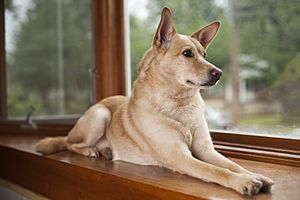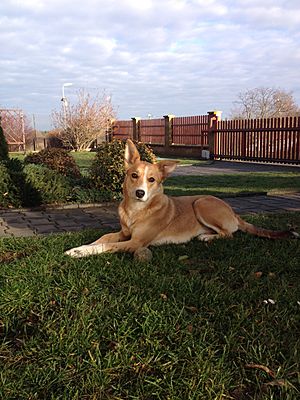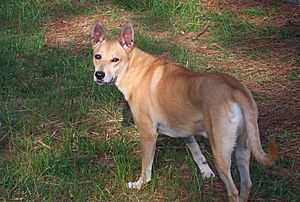Carolina Dog facts for kids
 |
|||||||||||||||||
| Origin | US | ||||||||||||||||
|---|---|---|---|---|---|---|---|---|---|---|---|---|---|---|---|---|---|
|
|||||||||||||||||
| Domestic dog (Canis lupus familiaris) | |||||||||||||||||
The Carolina Dog, also known as the American Dingo or Dixie Dingo, is a special type of dog. These medium-sized dogs are sometimes found living wild in the southeastern US. They especially like quiet areas with longleaf pines and cypress swamps.
People are working to make the Carolina Dog a recognized breed. It has already been accepted by two smaller kennel clubs. A major kennel club is also working towards its full recognition.
This dog breed was first found living freely in the wild. I. Lehr Brisbin Jr. helped bring attention to them. However, American dog books had mentioned them as early as the 1920s. DNA studies show that Carolina Dogs share some genes with dog breeds from East Asia.
| Top - 0-9 A B C D E F G H I J K L M N O P Q R S T U V W X Y Z |
Discovering the Carolina Dog
One of the first people to write about the "Indian" dogs of North America was Glover Morrill Allen in 1920. He thought these dogs came from ancient Asian dogs. He believed dogs first came from Asia and traveled with early people all over the world. This likely happened a very long time ago.
Allen mentioned studies from the late 1800s. These studies found dog bones from Alaska to Florida. They were even found in old Native American mounds. This showed that these dogs were widespread.
Cope (1893) was the first to describe the jaw of this dog from a specimen collected by Moore from a shell-mound on St. John's River, Florida. He was struck by the fact that the first lower premolar was missing and appeared not to have developed. He also noticed strong development of the entoconid of the carnassial.
Moore, in the course of various explorations in Florida and Georgia discovered many remains of dogs, apparently of this type. In a large mound on Ossabaw Island, Georgia, he (1897) found several interments of human and dog-skeletons, the latter always buried separately and entire, showing that the dogs had not been used as food. Other dog-skeletons of a similar sort were found by Moore (1899) in aboriginal mounds on the South Carolina coast ... Putnam considered them the same as the larger Madisonville (Ohio) dogs.
I. Lehr Brisbin Jr. helped make these dogs famous. He is an ecologist who studies nature. He first saw a Carolina Dog at the Savannah River Site. This area was closed off for many years, starting in 1950. This helped the wild dogs live undisturbed.
Getting Recognized as a Breed
Since 1996, you can register Carolina Dogs with the United Kennel Club (UKC). The UKC has a detailed description of what a Carolina Dog should look like. The UKC often focuses on hunting dogs and other working dogs. They put the Carolina Dog in their "Sighthound & Pariah Group". Other dogs in this group include the Basenji from Africa.
The American Rare Breed Association (ARBA) has also created a breed standard for the Carolina Dog. ARBA includes the Carolina Dog in their Group 5. This group also has the Canaan dog and the New Guinea singing dog.
In 2017, the American Kennel Club (AKC) started a program for the Carolina Dog. The AKC is the biggest dog registry in the US. This was the first step towards the Carolina Dog becoming officially recognized by the AKC. The AKC lists the dog in their "Hound" group.
What Carolina Dogs Look Like
Carolina Dogs are medium-sized. They are usually between 17 and 24 inches (45–61 cm) tall. They weigh from 30 to 65 pounds (15–30 kg).
Their ears are very special. They stand up straight, are long, and have pointed tips. They can move their ears to hear sounds from different directions. This gives them very good hearing.
These dogs can be slender and graceful, or a bit more muscular. Their legs are strong but look elegant. The back part of their body is firm and narrow. A healthy Carolina Dog looks strong and athletic. Their paws are quite large. Their snout and long, fox-like ears make them look a bit like a spitz dog. Their tail usually points up and often has a hook shape at the end. Their fur is usually short and smooth. This is common for dogs from warm places.
Their colors can be different. They might be reddish-ginger, light brown, fawn, black-and-tan, or have patches of different colors. They might have white areas on their toes, chest, tail tip, and muzzle. Their eyes are almond-shaped and set at a slight angle. Eye colors vary, but are often dark brown or orange. Many Carolina Dogs have a black "eyeliner" look around their eyes. This stands out more on lighter-colored dogs. Their lips are often black, even on light dogs. Puppies sometimes have a dark face mask that usually fades as they grow up.
How They Behave
Breeding in the Wild
Female Carolina Dogs can have three estrus cycles (times when they can get pregnant) quickly. When there are many puppies, they settle into seasonal breeding. This quick breeding helps them have many puppies in the wild. It helps them survive before diseases like heartworm can affect them.
DNA Clues About Their Past
In 1997, Brisbin thought that some Carolina Dog ancestors came to America with early people.
In 2013, a study looked at the mitochondrial DNA (mtDNA) of Carolina Dogs. This DNA is passed down from the mother. The study showed that many Carolina Dogs have DNA types found all over the world. But some had DNA types found in Korea and Japan. Also, a good number had a unique DNA type never seen before. This unique DNA type came from East Asia.
Another study in 2013 looked at several dog breeds in the Americas. These included the Carolina Dog, the Peruvian Hairless Dog, and the Chihuahua. This study also suggested that these dogs came from an ancient migration from East Asia.
In 2015, a large study looked at the DNA of many purebred dogs and village dogs from different countries. It checked how much they mixed with European dog breeds. The study found that Carolina Dogs had between 10%–35% DNA from before Columbus came to America. This DNA matched dogs from East Asia.
In 2018, a study compared DNA from old North American dog bones with old Siberian dog bones and modern dogs. It suggested that dogs came to North America from Siberia long after humans arrived. These dogs were then isolated for thousands of years. They disappeared after Europeans came, replaced by European dogs. The dogs from before European contact had a special genetic signature that is now gone. Their closest relatives are Arctic dog breeds. Three Carolina Dogs in this study showed some of this ancient DNA. However, the study couldn't rule out that this was due to mixing with modern Arctic dog breeds.
See also
 In Spanish: Perro de Carolina para niños
In Spanish: Perro de Carolina para niños




